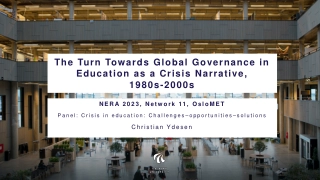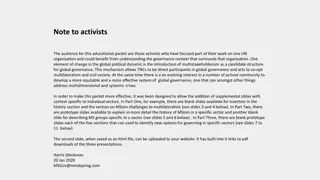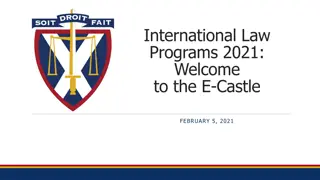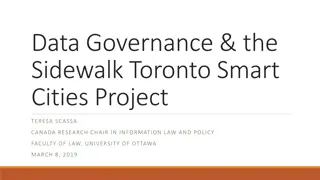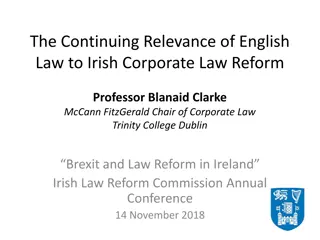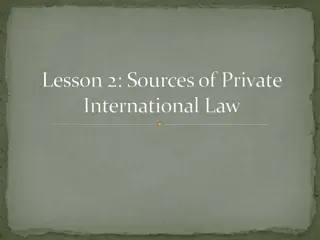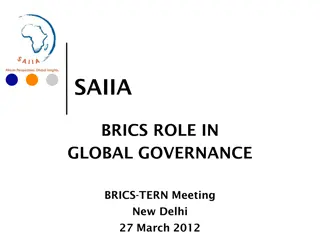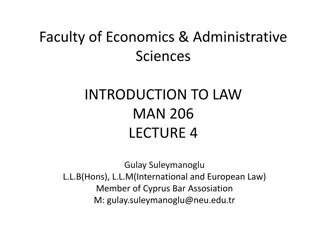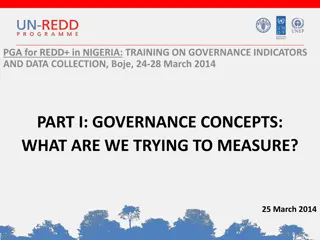Introduction to CIGI's ILRP - Shaping International Law for Global Governance
CIGI's International Law Research Program (ILRP) aims to improve global governance through innovative approaches and interdisciplinary research. Their objectives include producing world-class research, fostering learning and mentorship opportunities, and facilitating dialogue among policymakers, industry, and academia. The ILRP's mandate covers areas such as intellectual property law, economic law, environmental law, and emerging focus on indigenous law, with a focus on human security, rights, and development. The program also aims to generate highly qualified personnel in the field of international law.
Download Presentation

Please find below an Image/Link to download the presentation.
The content on the website is provided AS IS for your information and personal use only. It may not be sold, licensed, or shared on other websites without obtaining consent from the author.If you encounter any issues during the download, it is possible that the publisher has removed the file from their server.
You are allowed to download the files provided on this website for personal or commercial use, subject to the condition that they are used lawfully. All files are the property of their respective owners.
The content on the website is provided AS IS for your information and personal use only. It may not be sold, licensed, or shared on other websites without obtaining consent from the author.
E N D
Presentation Transcript
Introduction to CIGIs International Law Research Program November 12, 2016 www.cigionline.org
About CIGI CIGI-ILRP founding belief better international governance can improve lives of people everywhere, increase prosperity, ensure global sustainability, address inequality and safeguard human rights, and promote a more secure world
About the ILRP ILRP aims to develop expertise, capacity and leadership to shape international law to create an innovative, sustainable Canadian & global economy. ILRP s mission is to seek to connect knowledge, policy and practice to build the globalized rule of law to support international governance of the future
The ILRPs Objectives 1. Finding innovative and creative ways for international law to improve global governance [practical approaches and interdisciplinary research] 2. Producing world-class workshops, conferences, empirical case studies, reports and policy briefs covering the ILRP three streams 3. Providing opportunities for learning, mentorship, engagement and leadership in the field of international law 4. Facilitating dialogue between policy makers, industry and the academia
Scope of the ILRPs Mandate o International intellectual property law o International economic law o International environmental law o Emerging focus on international indigenous law The ILRP also supports: Complementary research that considers the impacts on human security, rights and development, Development of an international indigenous law program of research related to the ILRP s three core areas of study
Generating Highly Qualified Personnel At full capacity in 2016- 2017, the ILRP envisions having 15 full-time internal Research Fellows 30 external Fellows up to 30 Graduate Scholarship Students and several Student Clinical Practitioners spending residency period at CIGI Campus, Internal CIGI staff
Realizing Indigenous Rights in International Law
Overview of Presentation The presentation will explore the challenges faced by indigenous peoples in Canada to participating in the negotiation and development of international trade agreements. Explore the legal underpinnings as to why consultation may be required under Canada s Constitution, and also pursuant to requirements in United Nations Declaration of the Rights of Indigenous Peoples (UNDRIP). Provide the evolution of environmental provisions in trade agreements
Duty to Consult and Accommodate 35(1) Constitution Act, 1982: The existing aboriginal and treaty rights of the aboriginal people in Canada are hereby recognized and affirmed. Most s. 35 consultations mainly focus on statutory decisions which may infringe on Aboriginal and/or treaty rights. Supreme Court of Canada (SCC) has not yet ruled on whether the duty to consult applies to legislation; however, the court in Courtoreille v Canada, 2014 FC 1244 recognized that the duty can be triggered by the introduction of a bill into Parliament such as introduction of an Omnibus Bill that changed federal environmental assessment laws. Decision is currently under appeal.
Strategic Higher Level Decisions Decision in Rio Tinto v. Carrier Sekani Tribal Council [2010] 2 SCR 650 extended the scope Government action is not confined to decisions or conduct which have an immediate impact on lands and resources. A potential for adverse impact suffices. Thus, the duty to consult extends to strategic, higher level decisions that may have an impact on Aboriginal claims and rights. What about the negotiation of international agreements? Provisions in numerous Modern Treaties require consultation before Canada consents to be bound by a new International Treaty which would give rise to new international legal obligations that may adversely affect treaty rights.
Hupacasath First Nation v Minister of Foreign Affairs Canada Judicial review was an attempt to push the consultation envelope First case in Canada where a court was asked to determine whether there was a constitutional obligation to consult prior to ratification of an international investment treaty. First Nation concerned it may be not be able to conserve and protect its lands in accordance with its legal customs. Also took issue with arbitral dispute settlement process which applies international trade and investment law, and would not afford the same protections for Aboriginal rights and title as Canadian constitutional law.
Hupacasath First Nation v Minister of Foreign Affairs Canada The Federal Court, and later the FCA, determined that there was no duty on the government to consult prior to ratification of the treaty, as the potential adverse impacts of the international investment agreement on Aboriginal rights was found to be non-appreciable and speculative. However, the decision is useful: 1. FCA determined that it had the jurisdiction to hear a matter concerning treaty making, 2. Court held that an exercise of the government prerogative (treaty making) was appropriately reviewable FCA acknowledging the Crown s duty to consult with First Nations could extend to treaty making
Canada -EU Comprehensive Economic and Trade Agreement First Nations and other indigenous peoples in Canada have not been afforded the right to consultation, never mind accommodation of their concerns for recently signed trade and investment agreements. Unsurprisingly, indigenous peoples were not formally consulted about the potential impacts of agreement such as the Canada -EU Comprehensive Economic and Trade Agreement (CETA) on their treaties and rights.
Contrast to Wallonia Small region in Belgium called Wallonia, which only represents about 0.5 per cent of the total population of the EU refused, to permit Belgium to support the signing of CETA . The regional parliament feared that CETA would weaken legal, health and environmental standards and they also raised concerns about using an international tribunal to hear investment disputes under CETA, rather that under the jurisdiction of domestic courts. Unlike Hupacasath, Wallonia s concerns were not dismissed as speculative, but instead, delayed the signing process for days - this was even though the Walloon government had been kept informed by Belgium in the negotiations process
United Nation Declaration on the Rights of Indigenous Peoples UNDRIP is a resolution of the United Nations General Assembly which was adopted on September 13, 2007. UNDRIP articulates a series of rights for Indigenous peoples which go beyond the rights currently afforded Aboriginal peoples by s. 35 of the Constitution. Canada did not adopt UNDRIP in 2007, but in 2010, changed its position and endorsed the Declaration. The 2010 endorsement was heavily qualified, calling it aspirational and stated that it did not reflect customary international law nor change Canadian laws
Canadas 2nd endorsement Canada s 2nd endorsement of UNDRIP influenced by the Truth and Reconciliation Commission (TRC) of Canada 94 Calls to Action which included recommendations to implement UNDRIP. Carolyn Bennett, Minister of Indigenous and Northern Affairs announced at the 15th Session of United Nations Permanent Forum on Indigenous Issues that Canada was now a full supporter of the UNDRIP, without qualification. UNDRIP would be implemented in accordance with Canada s Constitution as through Section 35, Canada has a robust framework for the protection of Indigenous Rights.
Relevant Articles of UNDRIP Article 19 States shall consult and cooperate in good faith with the indigenous peoples concerned through their own representative institutions in order to obtain their free, prior and informed consent before adopting and implementing legislative or administrative measures that may affect them. Article 41 The organs and specialized agencies of the United Nations system and other intergovernmental organizations shall contribute to the full realization of the provisions of this Declaration Ways and means of ensuring participation of indigenous peoples on issues affecting them shall be established. Articles 19 and 41 complement each other as they create space for the participation of Indigenous peoples at the United Nations during the negotiations of international laws that impact them, as well as the requiring participation domestically as the government position is being crafted.
Differences from Canadian Law The language may effect vs. potential for an adverse impact in Article 19, is a far less stringent test i.e. no need to establish a non- speculative causal relationship between the proposed conduct and the potential for an adverse impact on Aboriginal rights. FPIC for legislative and administrative matters is to be undertaken with representative institutions, rather than the rights holders themselves. Over 600 recognized First Nation bands in Canada, and non-status and urban indigenous populations, as well as M tis and Inuit peoples. How to determine Canada s indigenous representative organizations for UNDRIP implementation is a live issue and the solution must lie with indigenous peoples themselves.
Special Rapporteur on the Rights of indigenous peoples In 2015, Victoria Tauli-Corpuz presented a report to the 70th Session of the UN General Assembly which outlined her belief that international investment agreements may directly violate indigenous rights. Unlike the Hupacasath decision, the Special Rapporteur found that non-discrimination and expropriation clauses in international investment agreements have the potential to undermine protection of land rights, cultural rights and may be a significant barrier to indigenous land claims. Recommends that States develop participatory mechanisms so that indigenous peoples have the ability to comment on the negotiation and drafting of the language in the proposed agreements
Collaboration with Indigenous Peoples In exploring whether there are domestic and international legal obligations to engage indigenous peoples on the development and negotiation of international environmental agreements, further research will be undertaken by CIGI, in partnership with indigenous communities in Canada, concerning: Specific treaty and Aboriginal rights to determine when the duty to consult may be triggered. Meetings with Indigenous communities and conducting workshops with leaders from Indigenous political institutions.
Environmental considerations for International Inter- tribal Trade
Evolution of Environmental Provisions in Trade Agreements World Trade Organization Agreement GATT Article XX sets out when WTO members may be exempted from WTO rules. Two exceptions are of particular relevance to the protection of the environment WTO members may adopt policy measures that are inconsistent, but(b) necessary to protect human, animal or plant life or health or (g)relating to the conservation of exhaustible natural resources 2 tier analysis: first, the measure must fall under at least one of the exceptions AND that the measure satisfies the requirements the chapeau of Article XX. Measure cannot be applied in a manner which would constitute a means of arbitrary or unjustifiable discrimination between countries where the same conditions prevail , and is not a disguised restriction on international trade . Committee on Trade and Environment created and discusses the relationship and trade and environmental matters
WTO Preamble Language Marrakesh Agreement 1994, establishing the WTO, Preamble, Para 1: Recognizing that their relations in the field of trade and economic endeavour should be conducted with a view to raising standards of living, ensuring full employment and a large and steadily growing volume of real income and effective demand, and expanding the production of and trade in goods and services, while allowing for the optimal use of the world s resources in accordance with the objective of sustainable development, seeking both to protect and preserve the environment and to enhance the means for doing so in a manner consistent with their respective needs and concerns at different levels of economic development. (Doha Ministerial Declaration 2001, Para 6: We strongly reaffirm our commitment to the objective of sustainable development, as stated in the Preamble to the Marrakesh Agreement. We are convinced that the aims of upholding and safeguarding an open and non-discriminatory multilateral trading system, and acting for the protection of the environment and the promotion of sustainable development can and must be mutually supportive. We take note of the efforts by members to conduct national environmental assessments of trade policies on a voluntary basis. We recognize that under WTO rules no country should be prevented from taking measures for the protection of human, animal or plant life or health, or of the environment at the levels it considers appropriate, subject to the requirement that they are not applied in a manner which would constitute a means of arbitrary or unjustifiable discrimination between countries where the same conditions prevail, or a disguised restriction on international trade, and are otherwise in accordance with the provisions of the WTO Agreements. We welcome the WTO s continued cooperation with UNEP and other inter-governmental environmental organizations. We encourage efforts to promote cooperation between the WTO and relevant international environmental and developmental organizations, especially in the lead-up to the World Summit on Sustainable Development to be held in Johannesburg, South Africa, in September 2002.
North American Free Trade Agreement - NAFTA Environmental Protection and sustainable development in the preamble Includes GATT Article XX language to allow for environmental exceptions. Article 104 sets out the relationship between NAFTA and Environmental Agreements If there is an inconsistency between NAFTA and the obligations in the Convention on International Trade in Endangered Species of Wild Fauna and Flora (CITES), Montreal Protocol on Substances that Deplete the Ozone Layer, Basel Convention on the Control of Transboundary Movements of Hazardous Wastes environmental requirements prevail to the extent of the inconsistency, provided that the Party chooses the alternative that is the least inconsistent with the other provisions of this Agreement. North American Agreement on Environmental Cooperation (NAAEC) side agreement to appease environmental concerns raised during negation of NAFTA
Provincial Trade Agreements ON/QC Trade and Cooperation Agreement Environmental provisions found throughout the Agreement and in the Preamble: MAINTAIN and enhance policies governing labour, the environment, consumer protection standards, health, education, culture and economic development; and PROMOTE sustainable development based on cooperation and mutually supportive environmental and economic policies including innovation for a green economy. Economic Co-operation includes commitments to environmental co- operation for transboundary pollution and also the development of a Cap and Trade system for Climate
ON/QC Trade and Cooperation Agreement cont. Similar to GATT Article XX language, legitimate objectives include: protection of human, animal and plant life or health; and protection of the environment; Chapter 11, Environment and Sustainable Development Chapter Provides greater protection for environmental measures and recognizes that environmental protection and conservation are an integral part of their economies for this generation and future generations .
CETA: the most environmentally progressive trade agreement? Search of CETA text includes over 100 substantive references to the environment and environmental protection and 50 references to sustainable development. Preamble also references legitimacy of environmental measures: RECOGNISING that the provisions of this Agreement preserve the right of the Parties to regulate within their territories and the Parties flexibility to achieve legitimate policy objectives, such as public health, safety, environment, public morals and the promotion and protection of cultural diversity.
CETA cont. Article XX of the GATT 1994 is incorporated into CETA . The Parties understand that the measures referred to in Article XX (b) of the GATT 1994 include environmental measures necessary to protect human, animal or plant life or health. The Parties understand that Article XX(g) of the GATT 1994 applies to measures for the conservation of living and non-living exhaustible natural resources. Includes Chapters on Environment and Sustainable Development.
International Inter-Tribal Trade and Investment How to incorporate the principles into a final Agreement? Respect for the Indigenous teachings and, where possible, apply these teachings to the issue of international inter-tribal trade and investment. Respect and preference for environmentally sustainable international inter-tribal trade and investment practices. Sharing of Indigenous trading practices following the organization s mandate to inform, educate and encourage all parties to Indigenous trade and investment to adopt these best practices where practicable. Fostering, through international inter-tribal trade and investment, healthy Indigenous communities and more robust and stable Indigenous economies New Opportunities: A renegotiated NAFTA? What would be the relationship with IITIO?
Questions? Thank you


